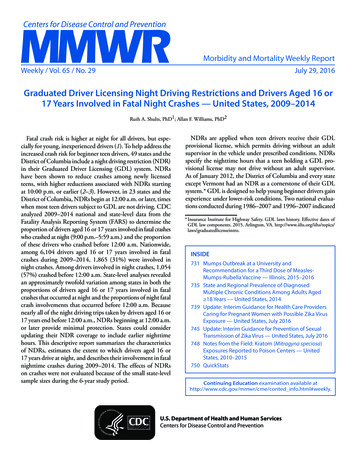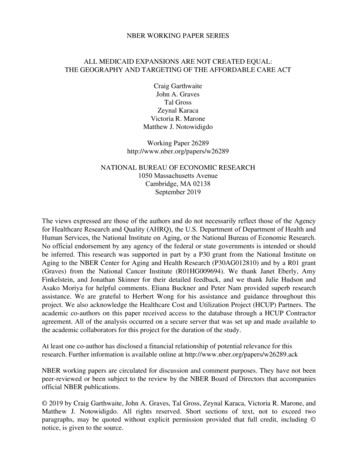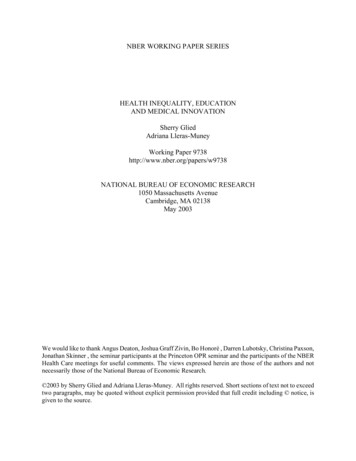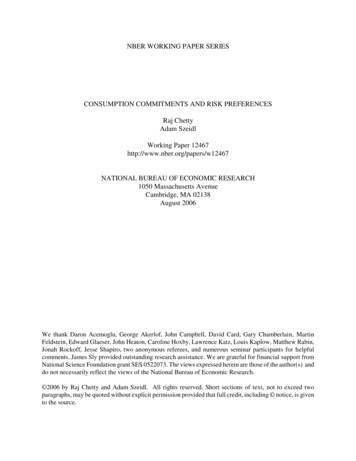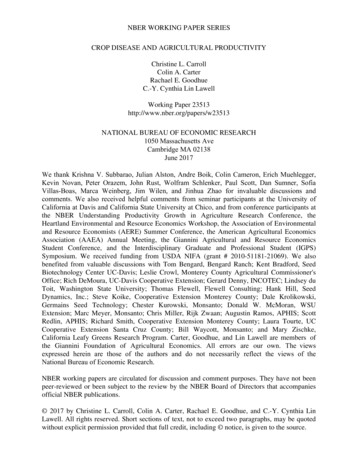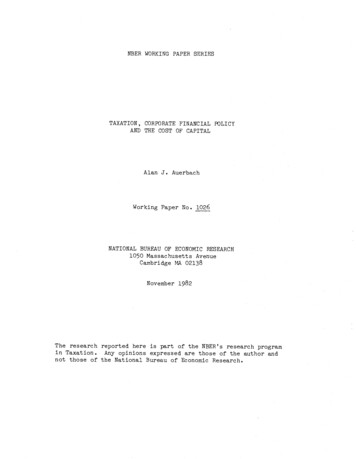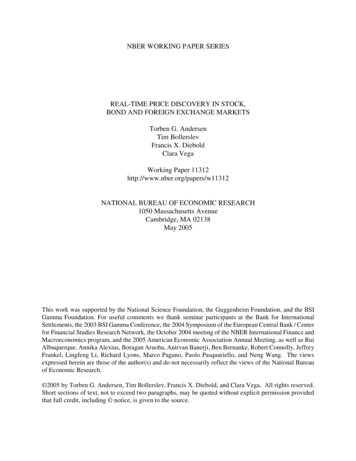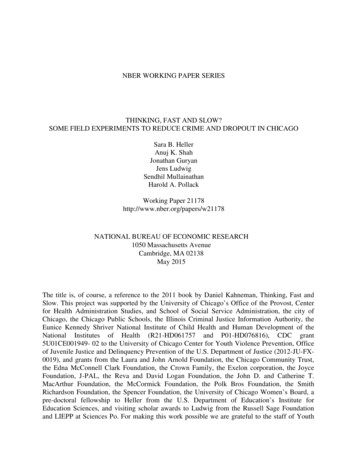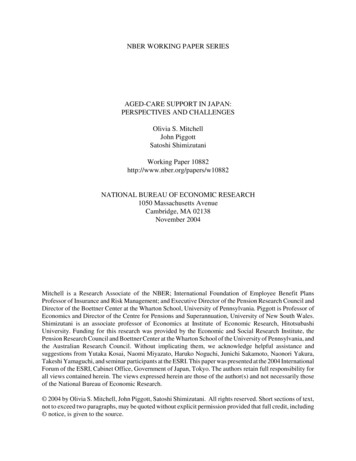
Transcription
NBER WORKING PAPER SERIESAGED-CARE SUPPORT IN JAPAN:PERSPECTIVES AND CHALLENGESOlivia S. MitchellJohn PiggottSatoshi ShimizutaniWorking Paper 10882http://www.nber.org/papers/w10882NATIONAL BUREAU OF ECONOMIC RESEARCH1050 Massachusetts AvenueCambridge, MA 02138November 2004Mitchell is a Research Associate of the NBER; International Foundation of Employee Benefit PlansProfessor of Insurance and Risk Management; and Executive Director of the Pension Research Council andDirector of the Boettner Center at the Wharton School, University of Pennsylvania. Piggott is Professor ofEconomics and Director of the Centre for Pensions and Superannuation, University of New South Wales.Shimizutani is an associate professor of Economics at Institute of Economic Research, HitotsubashiUniversity. Funding for this research was provided by the Economic and Social Research Institute, thePension Research Council and Boettner Center at the Wharton School of the University of Pennsylvania, andthe Australian Research Council. Without implicating them, we acknowledge helpful assistance andsuggestions from Yutaka Kosai, Naomi Miyazato, Haruko Noguchi, Junichi Sakamoto, Naonori Yakura,Takeshi Yamaguchi, and seminar participants at the ESRI. This paper was presented at the 2004 InternationalForum of the ESRI, Cabinet Office, Government of Japan, Tokyo. The authors retain full responsibility forall views contained herein. The views expressed herein are those of the author(s) and not necessarily thoseof the National Bureau of Economic Research. 2004 by Olivia S. Mitchell, John Piggott, Satoshi Shimizutani. All rights reserved. Short sections of text,not to exceed two paragraphs, may be quoted without explicit permission provided that full credit, including notice, is given to the source.
Aged-Care Support in Japan: Perspectives and ChallengesOlivia S. Mitchell, John Piggott, Satoshi ShimizutaiNBER Working Paper No. 10882November 2004JEL No. H53, H55, I11, I18, I38ABSTRACTThis study explores economic aspects of the market for long term care (LTC) with a special focuson Japan. First, we describe the LTC system in Japan as presently implemented, and we highlightsome aspects of the program that are novel and potentially of interest to other countries seekingmodels for long-term care provision. Next, we discuss alternative projections of Japanese LTCutilization and costs. Finally, since Japan appears likely to experience important shortfalls in LTCin the future, we discuss whether such services might be more efficiently organized and financedunder alternate forms of provision.Olivia S. Mitchell3641 Locust Walk, 304 CPCDepartment of Insurance & Risk ManagementWharton SchoolUniversity of PennsylvaniaPhiladelphia, PA 19104-6218and NBERmitchelo@wharton.upenn.eduJohn PiggottSchool of EconomicsUniversity of New South WalesSydney 2052, Australiaj.piggott@unsw.edu.auSatoshi ShimizutaniInstitute of Economic ResearchHitotsubashi University2-1 Naka, Kunitachi-shiTokyo, Japan 189-8603sshimizu@ier.hit-u.ac.jp
Aged-Care Support in Japan: Perspectives and Challenges“Veneration of the elderly – a central tenet of both Eastern and Western religiousand cultural traditions – obliges family and society to maintain and enhance thewell-being of those who are old, particularly if they need assistance.” Garber(1999:166)As global aging progresses, experts have begun to express concern regarding the extent and cost ofmedical and social services that might be absorbed by a rapidly growing older population. It is in thiscontext that long-term care (LTC) benefits become an important public policy issue with extraordinaryfiscal implications as the world ages. This paper explores the topic of aged-care support in Japan, seekingto both help explain the status quo and also to evaluate implications for the future. Of Japan’s 127 millionpeople, almost one-fifth are currently age 65 ; the fraction of the elderly, thus defined, is therefore halfagain as high as in the US, with 290 million people and 12% elderly, and Australia, which has 19.7 millionpeople and 13% elderly (USCIA, 2003).1 As populations age, there is increasing need for medical care forthe frail. Currently, in Japan, around 4% of the elderly live in nursing homes, a proportion similar to the US(AHCA, 2003; Ikegami and Yamada, 1996).We begin by describing the LTC system in Japan as presently implemented, and in doing so, wehighlight some aspects of the program that are of interest to analysts seeking new models for long-term careprovision. Next, we discuss alternative projections of aggregate Japanese LTC utilization and costs.Following this, we devote some attention to regional differences in entitlement and utilization rates, whichwill potentially require important cross-subsidization flows in years to come. Finally, since Japan appearslikely to experience important future shortfalls in LTC, we discuss possible roles for private provision ofLTC insurance services. Economic aspects of the market for LTC insurance are our main emphasis.Defining Long Term CareThough the term “long-term care” is widely used, there is no single agreed-on definition of the1In Japan, of the 127 million people, elderly men made up 9.9 million and elderly women 13.8 million; in the US ofthe 290 million, men were 14.9 million and women 21 million; and of the 19.7 million Australians, elderly men totaled1.1 million and elderly women 1.4 million (USCIA, 2003).
2concept. Medical experts such as Alan Garber (1996) equate the LTC concept with ongoing medical care,particularly that which is designed to comfort those who “suffer from the disabling effects of diseases andinjuries that medical treatment can neither cure nor fully relieve” (p. 143). Similarly, health economistssuch as Edward Norton (2000: 957) emphasize care provided to those with chronic medical conditions whorequire medical and palliative care. On the other hand, health services researchers such as Nelda McCall(2001: 3) propose a more expansive notion, one that encompasses a “continuum of medical and socialservices designed to support the needs of people living with chronic health problems that affect their abilityto perform everyday activities.” A broad approach to LTC is also taken by healthcare managementspecialists such as Pratt (1999: 6) who identifies LTC according to the users of these services. Those hedefines as people who are physically or mentally dependent on others, and who consequently require health,social, personal, and other services for a sustained period of time.Since experts differ in what they mean by LTC, it is not surprising that LTC providers are many anddiverse, and the product mix included in LTC varies by country and over time. Of course, the traditionalnexus of support for the elderly and disabled throughout history has been the family, with multigenerationalhouseholds exchanging goods and services in a mutual support system. People lacking that option wereforced to turn to “poorhouses” financed by charities and other welfare organizations (Pratt, 1999). In thelast 50 years, however, many developed countries experienced dramatic fertility declines and risinglongevity which contributed to rapid population aging. Combined with a more mobile population, thesefacts produced a sharp fall in multigenerational co-resident households, making it increasingly difficult forthe relatively small working-age cohort to care at home for its long-lived and needy elderlyparents/grandparents.Partly in response, governments in many developed nations have begun to establish, finance, andotherwise support nursing homes, often seen as the institutions most closely associated with the notion oflong-term care. Yet the range of services and institutions today associated with LTC is much wider,including the following (Pratt, 1999: 21-22): Nursing Facilities: Also known as nursing homes, these are residential institutions licensed by
3 government agencies that provide room and board as well as nursing care and some therapeuticservices. In the US, a further distinction is made between Subacute Care facilities which arevery high-level and usually short-stay nursing facilities; Skilled Nursing Facilities (SNF)which deliver intensive nursing services (e.g. IV treatments, occupational and physical therapy)over longer periods of time; and non-skilled nursing facilities which provide long-term andlower-level medical intervention.2Assisted Living/Residential Care facilities: This category of residential caregiving facilityaccepts people requiring assistance with both regular and instrumental activities of daily living.Adult Day Care services: These are non-residential programs providing consumers with meals,social and educational activities, and supervision.3Home Health Care services: Generally these offer consumers services in their own homes for afew hours a week, including a dietary consultation, a modest level of nursing attention, andsome therapy. 4Hospice Care: Support is offered by trained but often volunteer staff for those in the finalstages of a terminal illness.Experts often propose that these services and facilities should be thought of as arrayed along aso-called “continuum” of care. In the ideal case, a customer’s case would be managed in a coherent andintegrated way, and this care would be paid for without gaps. It is worth emphasizing, however, that inpractice the institutions and entities which provide care deemed useful and/or necessary for the physicallyand mentally dependent often are not integrated in a comprehensive way, either in terms of services orfinancing. Furthermore, even today, much of the care for the long-lived and needy elderly is still providedinformally by relatives in both the developed and developing world (McCall, 2001).Aged-care Provision in JapanThe current LTC system in Japan is a relatively recent addition to the country’s mandatory nationalhealth care system established in 1961. Under the Japanese national healthcare plan, individuals areassigned coverage for medical care based on their job or residential location (Ikegami and Campbell, 1999).Each employer or municipality (prefecture) then must offer mandatory healthcare coverage financed by2In many countries, people are classified as being “severely disabled” if they cannot execute at least two of the fiveActivities of Daily Living (ADLs; Weiner et al., 1994: 5). ADLs involve the ability to bath, dress, eat, maintaincontinence, self-toilet, and transfer in and out of bed. The typical US nursing home resident requires help with at least4 (ADLs), which makes it extremely difficult for them to remain in their own homes even with home care (MetLife2003). In the US, 4.5% of people 65 were in a nursing home in 2000 (MetLife 2003), but the percentage rose rapidlywith age: 18% of those 85 were in a nursing home. Nursing home costs in 2002 in the US cost 50-60,000 annually,just for room and board (MetLife 2003).3A simplified list of the so-called Instrumental Activities of Daily Living (IADLs) includes preparing meals, doinghousework, taking medication, shopping, using transportation, managing money, and using the telephone (Powell,1999).
4premiums levied on household heads (in the case of the community-based plans), or shared half byemployers and half by employees (for company-based plans; Ikegami, 2003). Self-employed workers arerequired to pay the entire healthcare premium themselves. National fee schedules are set by the governmentand apply to all providers in Japan; medical care providers are further prohibited from balance billing(Ikegami, 2003). In 2002, for instance, fees for medical procedures were cut by the central authority by1.3% overall, and by 5-30% for some services such as CT scans and MRIs. Drug fees are also set centrallyand were reduced 5% in 2002; drug competition is permitted only as long as prices are below thecentrally-set fee (Ikegami, 2003).When citizens reach retirement age, they are required to join the Citizens’ Health Insurance plan(CHI), a decentralized system providing various levels of home care and also institutional care. As part ofthis system and particularly from 1973 on, the frail elderly were entitled to free hospitalization even if theydid not require intensive medical care; as a consequence, by 1993 the elderly accounted for almost half ofall hospital beds and one-third stayed for more than one year (Campbell and Ikegami, 2000). Thisphenomenon, termed “social hospitalization,” was the target of reform under the Gold Plan of 1989 andrevised in 1994. Under this initiative, the central government instituted efforts to boost the number ofnursing home slots, adult day-care centers, and home health aid providers. At the same time, municipalitieswere given a key role in setting eligibility standards and determining who was entitled, in keeping withpublic assistance philosophy. It represented a formal acknowledgement that care for the frail elderly was aproblem of growing national consequence.The present Japanese LTC program was introduced in 2000, with four key objectives enunciated bythe Japan Ministry of Health, Labor, and Welfare (JMHLW, 2003a). First, the approach sought to reducethe burden of home care of the elderly, a burden traditionally borne by women. In other words, thisprogram represented a major shift in the responsibility for elderly care away from the family, and towardthe state (Campbell and Ikegami, 2000). Second, the new system sought to make more transparent the4In the US, paid home care services were used by 28% of people 50-64 needing help with ADLs, and 48% of thoseage 75-84 (MetLife 2003). Hourly rates for home health aides averaged 18/hour in 2003 (MetLife 2003).
5relationship between benefits received and premiums paid. Third, the new program was designed tointegrate what had been a vertically-divided system of health, medical, and welfare services operatingrelatively independently, so as to provide a means by which customers would receive comprehensiveservices from a variety of institutions of their choice. Fourth, by separating long-term care from healthinsurance coverage, the new insurance program sought to reduce the number of “social hospitalization”cases where elderly were hospitalized simply because of a lack of viable alternatives.Program BenefitsFocusing first on system benefits under the Japanese public LTC system, the program is explicitlyintended to provide both in-home services (at-home care) and also services at facilities (institutional care).5All persons age 65 are eligible, along with people age 40-64 with health-related disabilities. Eligibility isdetermined based on condition, rather than income and/or assets, and it must be reevaluated every sixmonths (Campbell and Ikegami, 2000).To receive LTC benefits, an individual must undergo a lengthy and information-intensivedisclosure process, beginning with application to an expert committee which collects extensive informationand applies a computer algorithm to 85 data inputs, including the applicant’s income, assets, and healthinformation (Ikegami, 2003). Facilities-based services are offered only to customers who are certified bythe LTC expert committee as needing such care based on health status. These committees must make ascreening determination based on the opinions of doctors within 30 days of application (Campbell andIkegami, 2000). Though standards for long-term care requirement certification are intended to be nationallyuniform and objectively determined, in fact, each municipality appoints its own examiner group comprisedof physicians and other care providers. It is worth noting that municipal government officials having budgetresponsibilities do not serve on these examiner committees, which may diminish incentives for cost-cutting(Campbell and Ikegami, 2000).At the time a person is certified in need of LTC, he is further determined as falling into one of5Unless otherwise noted this discussion is adapted from JMHLW (2003).
6health condition groupings identified as Care Levels 1-5, versus “support required.” 6 Benefit entitlementscorrespond to each care level, though services provided may vary across regions. On the whole, long-termcare “welfare” facilities mainly focus on the consumer’s activities of daily living, while health facilities aremainly oriented toward rehabilitation. LTC medical facilities are mainly health-care delivery institutions.As an example, the financial value accorded to in-home benefits and home-visit outpatient services variedin 2003 from 62,000- 358,000/month, and for short-stay service, people are entitled to 7-42 days in afacility every 6 months. Facility benefits are determined according to the level of long-term care required.After the municipality board assesses the customer’s eligibility and level of care needed, he is referred to acare manager who then consults with the customer as well as the patient’s doctor. After the customerapproves the care plan, the care services actually delivered; customers are permitted to switch caremanagers at will.Two types of services are offered under the LTC program. In-home services include a variety ofofferings including (1) home-visit/day services (home-visit long-term care, home-visit bathing, home-visitrehabilitation, day rehabilitation (day care), home-visit nursing care, day service, welfare devices leasing);(2) short-stay service/short-stay care; (3) in-home medical care management counselling; (4) care servicefor the elderly with dementia; (5) care service provided in for-profit private homes for the elderly; (6)allowance for purchase of welfare devices; and (7) allowance for home renovation (handrails, removal oflevel differences, etc.). Services at facilities are described according to three types of nursing homes: (1)long-term care welfare facilities for the elderly (special nursing homes for the elderly); (2) long-term care6The categories of care are as follows: the first or lowest care level category is the so-called “Support Required”condition; here the consumer lives independently but requires any assistance for Instrumental Activities of DailyLivings (IADLs) such as taking medication and phone calls. Above this, five levels of “Care Required” aredistinguished, all of which require that the consumer cannot live independently but requires care in basic Activities ofDaily Lives (ADLs). Care Level 1 is defined as having more IADLs than the “Support Required” category; thisindividual would require partial care for daily living and care for IADL. Care Level 2 is defined as having additionalneed for help with ADLs in addition to the problems defined above. Care Level 3 requires more help with both IADLsand ADLs than Care Level 2 and the individual would require total care. Care Level 4 is defined as having allpreviously described conditions along with worse functioning in the ADL area; such an individual would find itdifficult to live without care. Care Level 5 is defined as finding it impossible to live without care, and having worseADLs than Care Level 4. To ensure uniformity of certification, primary judgment is based on estimating a consumer’srequired “minutes of care” required per day as well as other indicators of dementia. These are described as typicalrequirements for each care level: Care Required: 25-32 minutes; Care Level 1: 32-50 minutes; Care Level 2: 50-70
7health facilities for the elderly; and (3) long-term care medical facilities for the elderly. The last type alsoincludes sanatorium-type wards as well as wards for elderly patients with dementia, and hospitals withenhanced long-term care service provision. Medical care, per se, is not included in the LTC program butinstead is offered under the national healthcare system.Rates for all covered LTC services are set by the JMHLW and are based on the units concept. TheMinistry has allocated a given number of "units" to particular services, where a unit varies with the serviceinvolved and by region (taking into account some degree of regional wage differentials of serviceproviders). A unit’s value is currently set at about 10; this will be revised every three years. For example,231 units are associated with home-help service care ranging from 0.5-1 hour (as of April 2003), regardlessof the actual level of care administered. This means that the price of home-help service in a typical area is 2,310. The number of units assigned to institutional care depends on the customer’s required care level.For example, in a typical long-term care welfare facility, 959 units per day are allocated to a Care Level 5case, and 677 units are associated with a day in a Care Level 1 environment. Further detail on the unitallowances for different types of care is provided in Table 1, arrayed by the condition of the elderly person.Program FinancingTurning to financing, the Japanese public LTC system is operated as a pay-as-you-go program,financed by both earmarked premiums levied on insured persons and general tax revenue. Half of theprogram costs are paid by premiums assessed on workers (age 40 ) and their employers as well as retirees(deducted from their public pensions); these premiums are collected by municipalities.7 Workers under theage of 40 do not currently pay premium taxes into the LTC system.It is worth emphasizing that the LTC premiums are means-tested: for example, the “basic”premium is 3,293/month for “Category 1” individuals (JMHLW, 2003), but it is higher for othercategories of individuals. Category 1 individuals must be age 65 , among whom some are exempted frommunicipal taxes by virtue of having very low income; the group also includes those on public assistance,minutes; Care Level 3: 70-90 minutes; Care Level 4: 90-110 minutes; Care Level 5: Over 110 minutes.7A recent study by Komamura and Yamada (2004) offers evidence that much of the employer’s contribution is also
8people with confirmed disability, and widows and widowers whose total income in the previous year is lessthan 1.25 million yen. Category 2 persons are those age 40-64 who are insured by the national healthinsurance system. A Category 2 individual having income under 2.5 million annually pays a LTCpremium of 1.25 times the “basic” amount, while an individual with income over that threshold must pay apremium set at 1.5 times the “basic” amount.8 Premiums also vary across municipalities; after settingpremium levels in 2000 and revising them in 2003, the expectation is that premiums will be revised everythree years going forward.Annual LTC expenditures in 2002 totalled 5.2 trillion (AJFNHIO, 2002). This is composed ofpremiums worth just over half of a percent of workers’ annual earnings covering about one-third of the totalprogram cost (Campbell and Ikegami, 2000). Premiums paid by the elderly (age 65 ) cover 17% of theprogram’s costs, and the rest of the costs are paid by the central government (25% of the cost), prefectures(12.5%), and municipalities (12.5%).In addition to premiums, eligible consumers must pay additional out-of-pocket amounts for LTCservices and care. An eligible person must pay a 10% co-insurance amount for each insured service. Forinstance, if home-help service care is priced at 2,310 per hour, the customer would pay 231 for thatservice and the municipality pays the rest. The customer is also responsible for meal charges when in anursing home. These co-pays are set by service and type of care, and vary depending on the consumer’s carelevel but not his income level. After spending up to a threshold, the consumer is responsible for 100% ofany additional costs until hitting a stop-loss threshold called the “high-cost long-term care service limit.”Above that threshold, additional expenses incurred by the consumer are covered by the LTC program at100%.The stop-loss threshold is reduced for low-income consumers, in some cases by more than half.9 In2003, for instance, a Care Level 3 consumer faced an out-of-pocket limit for care services of 26,750paid for by workers, shifted to employees in the form of lower wages.8In addition, these premiums may be exempted and/or reduced “at times of emergencies” according to the JMHLWwebsite.9An old-age welfare pension recipient has an out-of-pocket limit of 15,000/month; a municipal tax-exempted
9units/month, with one unit equal to 10. In other words, he was eligible to use care services worth 267,500in a month simply by paying 26,750. For meals, the standard charges amounted to 23,400/mo (or 780/day). If the cost of services consumed exceeded this limit, the consumer would have to pay for all theadditional services, up to an out-of-pocket maximum of 37,200/month for a non means-tested consumer.After that point, all additional costs would be paid by the system.Public LTC Service Utilization and Cost ProjectionsTo evaluate how the public component of Japanese LTC may evolve over time as the populationages, it is useful to assess models of utilization and cost projections. In Japan, as elsewhere, LTCprojections are fraught with uncertainty. Often analysts take existing utilization patterns and multiply thenby population projections, though this can result in imperfect projections because of changes in demand dueto subsidized care. There may also be changes in demand if copays and deductibles are raised, or if theexistence of the LTC system contributes to the rehabilitation and recovery from illness and injury. Inaddition, some experts project substantial declines in future utilization rates as a result of more resilientolder populations. For instance Fries (1980) contended in a controversial but influential paper that“[e]xtension of adult vigor far into a fixed life span compresses the period of senescence near the end oflife.” Subsequent research offers additional empirical support of this view including Lubitz et al. (2003)who suggests that longer lifespans may not necessarily boost healthcare spending per capita. In any event,future morbidity declines will probably not offset much of the cost increases attributable to the rise in thefraction of the population that is elderly (Garber, 1999).The All-Japan Federation of National Health Insurance Organizations (AJFNHIO, 2003) estimatedthat 3.7 million persons were certified as in need of some LTC in 2003. Of these, only 2.7 million receivedcare, with at-home care users totalling 2 million (58%) and institutional care users totalling 0.7 million(20%). Projections of possible future LTC need and utilization are offered by the Japanese Ministry ofHealth, Labor, and Welfare (JMLHW), which relies on methodology developed by the Research Group onElderly Care and Support Systems for Autonomous Living (the precise methodology has not yet beenperson’s limit is 24,600/month; and a regular taxpayer has a limit of 37,200/month.
10explicated formally so the resulting estimates are quasi-official). It is known that the office estimated thenumber of demented elderly for every five years going forward, from 2005 to 2045, and it also estimatedgovernment net expenditures (aka “Evaluation Payments”) for 2005, 2015, and 2025.Kishida (1998) estimated the number of elderly needing care using a different model, and itindicated far more shortfalls than found by the MLHW. Relying on 1993 incidence rates from the MLHW,he concluded that more people would require care over time than the government estimated. In fact, by2020 he estimated that the number needing care would rise to 4.8 million (assuming a 3% annual growthrate) and that the population needing care would grow until 2030. He used the “current” unit costs of LTCin these projections, and obtained overall net cost estimates higher than the JMHW’s 1995 estimates: theMinistry had forecast costs of 4.2 trillion for 2000, while Kishida’s projections totalled 8.5 trillion. Inaddition to differences in projected numbers of users, Kishida took a more comprehensive view of cost; heincluded living expenses for elderly and imputed a value to the care provided by family members to theelderly (no breakdown was provided, however, of exactly comparable numbers).Table 2 assembles some future projections of elderly eligibles and costs of LTC in Japan. Theserely on historical data for the number of elderly requiring LTC in Japan during the 1990s (see Table 3). Ofcourse, utilization patterns could well be higher since the current LTC program only went into effect in2000; in view of population aging and likely increased demand for LTC services, an extrapolation ofhistorical trends may underestimate future LTC costs. Table 4 reports the official projections of the numberof elderly expected as of 2025 as well as the number of frail, bedridden, weak, and those expected to needLTC services at that point.Using these numbers, one may try to bound the range of estimates for aggregate LTC costs in Japanby 2025. On the assumption that care prices remain constant over time and that the share of users does notchange, total costs would rise by virtue of population aging alone from 5.2 trillion currently to reach 9trillion (AJFNHIO, 2002). If, instead, at-home and institutional user prices are fixed, but the share ofat-home users rises at historical rates, projected expenditures would exceed 10 trillion. Further, allowingboth the number of at-home users and the price of home care (but not institutional care) to rise at historical
11rates would boost total estimated costs to 26 trillion. Finally, the estimates would be much higher if bothprice and utilization rates for institutional users were projected to rise at historical rates. Microeconomicpanel data will be required to refine these projections, permitting the development of statistical transitionmatrices between health status categories influencing healthcare utilization and cost patterns.10Regional Differences in Dependency, Capacity, Utilization and CostsOne interesting aspect of the Japanese LTC system is that some aspects are highly centralized,while
Wharton School University of Pennsylvania Philadelphia, PA 19104-6218 and NBER mitchelo@wharton.upenn.edu John Piggott School of Economics University of New South Wales Sydney 2052, Australia j.piggott@unsw.edu.au Satoshi Shimizutani Institute of Economic Research Hitotsubashi University 2-1 Naka, Kunitachi-shi Tokyo, Japan 189-8603 sshimizu .
